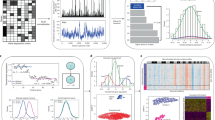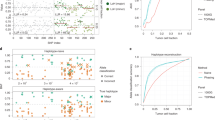Abstract
A substantial proportion of tumors consist of genotypically distinct subpopulations of cancer cells. This intratumor genetic heterogeneity poses a substantial challenge for the implementation of precision medicine. Single-cell genomics constitutes a powerful approach to resolve complex mixtures of cancer cells by tracing cell lineages and discovering cryptic genetic variations that would otherwise be obscured in tumor bulk analyses. Because of the chemical alterations that result from formalin fixation, single-cell genomic approaches have largely remained limited to fresh or rapidly frozen specimens. Here we describe the development and validation of a robust and accurate methodology to perform whole-genome copy-number profiling of single nuclei obtained from formalin-fixed paraffin-embedded clinical tumor samples. We applied the single-cell sequencing approach described here to study the progression from in situ to invasive breast cancer, which revealed that ductal carcinomas in situ show intratumor genetic heterogeneity at diagnosis and that these lesions may progress to invasive breast cancer through a variety of evolutionary processes.
This is a preview of subscription content, access via your institution
Access options
Access Nature and 54 other Nature Portfolio journals
Get Nature+, our best-value online-access subscription
$29.99 / 30 days
cancel any time
Subscribe to this journal
Receive 12 print issues and online access
$209.00 per year
only $17.42 per issue
Buy this article
- Purchase on Springer Link
- Instant access to full article PDF
Prices may be subject to local taxes which are calculated during checkout





Similar content being viewed by others
Accession codes
References
Gerlinger, M. et al. Intratumor heterogeneity and branched evolution revealed by multiregion sequencing. N. Engl. J. Med. 366, 883–892 (2012).
Navin, N. et al. Tumor evolution inferred by single-cell sequencing. Nature 472, 90–94 (2011).
Aparicio, S. & Caldas, C. The implications of clonal genome evolution for cancer medicine. N. Engl. J. Med. 368, 842–851 (2013).
Ng, C.K. et al. Intratumor genetic heterogeneity and alternative driver genetic alterations in breast cancers with heterogeneous HER2 gene amplification. Genome Biol. 16, 107 (2015).
Hernandez, L. et al. Genomic and mutational profiling of ductal carcinomas in situ and matched adjacent invasive breast cancers reveals intratumor genetic heterogeneity and clonal selection. J. Pathol. 227, 42–52 (2012).
de Bruin, E.C. et al. Spatial and temporal diversity in genomic instability processes defines lung cancer evolution. Science 346, 251–256 (2014).
Yates, L.R. et al. Subclonal diversification of primary breast cancer revealed by multi-region sequencing. Nat. Med. 21, 751–759 (2015).
Ng, C.K., Schultheis, A.M., Bidard, F.C., Weigelt, B. & Reis-Filho, J.S. Breast cancer genomics from microarrays to massively parallel sequencing: paradigms and new insights. J. Natl. Cancer Inst. 107, djv015 (2015).
Ding, L. et al. Clonal evolution in relapsed acute myeloid leukemia revealed by whole-genome sequencing. Nature 481, 506–510 (2012).
Nik-Zainal, S. et al. The life history of 21 breast cancers. Cell 149, 994–1007 (2012).
Carter, S.L. et al. Absolute quantification of somatic DNA alterations in human cancer. Nat. Biotechnol. 30, 413–421 (2012).
Roth, A. et al. PyClone: statistical inference of clonal population structure in cancer. Nat. Methods 11, 396–398 (2014).
Wang, Y. et al. Clonal evolution in breast cancer revealed by single-nucleus genome sequencing. Nature 512, 155–160 (2014).
Baslan, T. et al. Optimizing sparse sequencing of single cells for highly multiplex copy-number profiling. Genome Res. 25, 714–724 (2015).
Baslan, T. et al. Genome-wide copy-number analysis of single cells. Nat. Protoc. 7, 1024–1041 (2012).
Leung, M.L., Wang, Y., Waters, J. & Navin, N.E. SNES: single -nucleus exome sequencing. Genome Biol. 16, 55 (2015).
Voet, T. et al. Single-cell paired-end genome sequencing reveals structural variation per cell cycle. Nucleic Acids Res. 41, 6119–6138 (2013).
Zardavas, D., Irrthum, A., Swanton, C. & Piccart, M. Clinical management of breast cancer heterogeneity. Nat. Rev. Clin. Oncol. 12, 381–394 (2015).
Gilbert, M.T. et al. The isolation of nucleic acids from fixed, paraffin-embedded tissues—which methods are useful when? PLoS One 2, e537 (2007).
Zheng, Z. et al. Anchored multiplex PCR for targeted next-generation sequencing. Nat. Med. 20, 1479–1484 (2014).
Van Allen, E.M. et al. Whole-exome sequencing and clinical interpretation of formalin-fixed, paraffin-embedded tumor samples to guide precision cancer medicine. Nat. Med. 20, 682–688 (2014).
Greer, C.E., Peterson, S.L., Kiviat, N.B. & Manos, M.M. PCR amplification from paraffin-embedded tissues. Effects of fixative and fixation time. Am. J. Clin. Pathol. 95, 117–124 (1991).
van Beers, E.H. et al. A multiplex-PCR predictor for aCGH success of FFPE samples. Br. J. Cancer 94, 333–337 (2006).
Adams, S. et al. Prognostic value of tumor-infiltrating lymphocytes in triple-negative breast cancers from two phase 3 randomized adjuvant breast cancer trials: ECOG 2197 and ECOG 1199. J. Clin. Oncol. 32, 2959–2966 (2014).
Hosein, A.N. et al. Evaluating the repair of DNA derived from formalin-fixed paraffin-embedded tissues prior to genomic profiling by SNP–CGH analysis. Lab. Invest. 93, 701–710 (2013).
Bosso, M. & Al-Mulla, F. Whole-genome amplification of DNA extracted from FFPE tissues. Methods Mol. Biol. 724, 161–180 (2011).
Dean, F.B. et al. Comprehensive human genome amplification using multiple displacement amplification. Proc. Natl. Acad. Sci. USA 99, 5261–5266 (2002).
Zong, C., Lu, S., Chapman, A.R. & Xie, X.S. Genome-wide detection of single-nucleotide and copy-number variations of a single human cell. Science 338, 1622–1626 (2012).
Garvin, T. et al. Interactive analysis and assessment of single-cell copy-number variations. Nat. Methods 12, 1058–1060 (2015).
Deleye, L. et al. Whole-genome amplification with SurePlex results in better copy-number alteration detection using sequencing data compared to the MALBAC method. Sci. Rep. 5, 11711 (2015).
Lakhani, S.R., Ellis, I.O., Schnitt, S.J., Tan, P.H. & van de Vijver, M.J. WHO Classification of Breast Tumors (IARC, 2012).
Sakr, R.A. et al. PI3K pathway activation in high-grade ductal carcinoma in situ—implications for progression to invasive breast carcinoma. Clin. Cancer Res. 20, 2326–2337 (2014).
Wolff, A.C. et al. Recommendations for human epidermal growth factor receptor 2 testing in breast cancer: American Society of Clinical Oncology–College of American Pathologists clinical practice guideline update. J. Clin. Oncol. 31, 3997–4013 (2013).
Hammond, M.E. et al. American Society of Clinical Oncology–College Of American Pathologists guideline recommendations for immunohistochemical testing of estrogen and progesterone receptors in breast cancer. J. Clin. Oncol. 28, 2784–2795 (2010).
Piscuoglio, S. et al. Uterine adenosarcomas are mesenchymal neoplasms. J. Pathol. 238, 381–388 (2016).
Weigelt, B., Warne, P.H., Lambros, M.B., Reis-Filho, J.S. & Downward, J. PI3K pathway dependencies in endometrioid endometrial cancer cell lines. Clin. Cancer Res. 19, 3533–3544 (2013).
Weinreb, I. et al. Hotspot-activating PRKD1 somatic mutations in polymorphous low-grade adenocarcinomas of the salivary glands. Nat. Genet. 46, 1166–1169 (2014).
Wersto, R.P. et al. Doublet discrimination in DNA cell-cycle analysis. Cytometry 46, 296–306 (2001).
Langmead, B., Trapnell, C., Pop, M. & Salzberg, S.L. Ultrafast and memory-efficient alignment of short DNA sequences to the human genome. Genome Biol. 10, R25 (2009).
Li, H. & Durbin, R. Fast and accurate short-read alignment with Burrows–Wheeler transform. Bioinformatics 25, 1754–1760 (2009).
Venkatraman, E.S. & Olshen, A.B. A faster circular binary segmentation algorithm for the analysis of array CGH data. Bioinformatics 23, 657–663 (2007).
Shen, R. & Seshan, V.E. FACETS: allele-specific copy-number and clonal heterogeneity analysis tool for high-throughput DNA sequencing. Nucleic Acids Res. 44, e131 (2016).
Curtis, C. et al. The genomic and transcriptomic architecture of 2,000 breast tumors reveals novel subgroups. Nature 486, 346–352 (2012).
Landau, D.A. et al. Evolution and impact of subclonal mutations in chronic lymphocytic leukemia. Cell 152, 714–726 (2013).
Schultheis, A.M. et al. Massively parallel sequencing–based clonality analysis of synchronous endometrioid endometrial and ovarian carcinomas. J. Natl. Cancer Inst. 108, djv427 (2016).
Schliep, K.P. phangorn: phylogenetic analysis in R. Bioinformatics 27, 592–593 (2011).
van de Wiel, M.A. & Wieringen, W.N. CGHregions: dimension reduction for array CGH data with minimal information loss. Cancer Inform. 3, 55–63 (2007).
Krasnitz, A., Sun, G., Andrews, P. & Wigler, M. Target inference from collections of genomic intervals. Proc. Natl. Acad. Sci. USA 110, E2271–E2278 (2013).
Acknowledgements
We thank the M. Wigler lab (CSHL) for kindly providing access to necessary equipment, and M. Schatz, T. Garvin and R. Aboukhalil (CSHL) for their assistance with Ginkgo, an interactive, online platform for the analysis of CNAs from single cells. We thank the CSHL Flow Cytometry Shared Resources, which is supported in part by the National Cancer Institute Cancer Center Shared Grant award number CA045508. We thank S. Turcan and J. Taranda for critically reviewing the manuscript. This work was funded in part by a Susan G. Komen Investigator-Initiated Research Grant (IIR13265578; J.B.H., J.S.R.-F., T.A.K. and B.W.), and by the MSKCC Single-Cell Sequencing Initiative (T.B.) and the William and Joyce O'Neil Research Fund (T.B.). S.P. was funded in part by a Susan G. Komen Postdoctoral Fellowship grant (PDF14298348). J.S.R.-F. is funded in part by the Breast Cancer Research Foundation. Research reported in this publication was supported in part by the Cancer Center Support Grant of the US National Institutes of Health–National Cancer Institute (P30CA008748; MSKCC). The content is solely the responsibility of the authors and does not necessarily represent the official views of the US National Institutes of Health.
Author information
Authors and Affiliations
Contributions
J.S.R.-F., B.W. and J.B.H. conceived and supervised the study; L.G.M. developed the single-cell FFPE methodology, and designed and conducted the experiments; T.B. and J.K. conducted the bioinformatics and statistical analyses of the single-cell data; K.A.B. and C.K.Y.N. performed the bioinformatics analysis of WES data; M.S. performed single-cell data preprocessing for use in the Ginkgo platform; S.P. prepared the FFPE and frozen blocks for cell lines; L.S. prepared the sequencing libraries for the FFPE and frozen cell lines and performed confocal microscopy of sorted nuclei; K.C. and G.N. conducted the FISH experiments, which were analyzed by K.C., G.N. and F.C.G.; T.A.K. and H.Y.W. provided tumor samples; J.S.R.-F. and F.C.G. reviewed and microdissected the histological samples; P.M., L.R. and S.D'I. performed flow cytometric analysis and sorting; T.B. prepared the LP–WGS libraries; H.C., A.S. and A.d.C.P. prepared the WES libraries; L.G.M., T.B., J.K., L.N., B.W., J.B.H. and J.S.R.-F. analyzed, discussed and interpreted the data; L.G.M., T.B., J.K., B.W., J.B.H. and J.S.R.-F. wrote the manuscript. All authors reviewed and approved the manuscript for submission.
Corresponding authors
Ethics declarations
Competing interests
The authors declare no competing financial interests.
Supplementary information
Supplementary Figures and Tables
Supplementary Figures 1–10 and Supplementary Tables 1–3 (PDF 8826 kb)
Supplementary Table 4
Whole-Exome Sequencing Statistics And Somatic Mutations Identified In The Dcis And Idc Of Case 3 By Whole-Exome Sequencing (XLSX 42 kb)
Rights and permissions
About this article
Cite this article
Martelotto, L., Baslan, T., Kendall, J. et al. Whole-genome single-cell copy number profiling from formalin-fixed paraffin-embedded samples. Nat Med 23, 376–385 (2017). https://doi.org/10.1038/nm.4279
Received:
Accepted:
Published:
Issue Date:
DOI: https://doi.org/10.1038/nm.4279
This article is cited by
-
Progression from ductal carcinoma in situ to invasive breast cancer: molecular features and clinical significance
Signal Transduction and Targeted Therapy (2024)
-
TP-0184 inhibits FLT3/ACVR1 to overcome FLT3 inhibitor resistance and hinder AML growth synergistically with venetoclax
Leukemia (2024)
-
Genomic and epigenomic basis of breast invasive lobular carcinomas lacking CDH1 genetic alterations
npj Precision Oncology (2024)
-
Breast cancers as ecosystems: a metabolic perspective
Cellular and Molecular Life Sciences (2023)
-
MEDICC2: whole-genome doubling aware copy-number phylogenies for cancer evolution
Genome Biology (2022)



